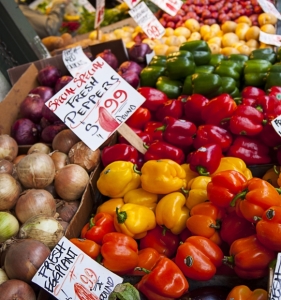>> Recently I overheard two women chatting at the farmer’s market, considering a case of artisanal beets.
Recently I overheard two women chatting at the farmer’s market, considering a case of artisanal beets.
“I mean it’s just common sense,” the first opined. “Why would I want to feed my kids garbage?”
“There’s, like, five farmers markets a week here,” added in the other, conveniently. “I can’t see any excuse for eating Cheetos.”
I’m going to stop right here and admit that those ladies were completely fictionalized. But the sentiment is true. Everywhere I go I see parents turning up their noses at Gogurts and salted pretzels, saying they are making a moral statement on behalf of their family by only eating local, or vegetables, or hand-whittled bespoke green beans.
And you know what? That’s awesome. Hooray for them. A recent study from Harvard found that >>some Americans are eating healthier today than at any other stage in industrialized history. Some folks are eating whole grains, green veggies, and are skipping the trans fats. But the point I see a lot of people missing—even the lovely, socially aware vegans—is that having the ability to choose your foods >>is a privilege that many of the people in our state can’t fathom.
>>That same Harvard study found that, for the poorest Americans, diets are getting worse. And for those families, it’s not a case of not enough farmer’s markets, or ignorance about the benefits of fresh squash and couscous. North Carolina’s low income workers are now balancing household budgets that have to go farther with less. With the >>minimum wage set below poverty levels and food stamp benefits barely covering the essentials, a large percent of North Carolinans >>just can’t afford to eat well.
Here’s some basic math: this week frozen pizzas are five for $5 at my local supermarket. Each pizza is good to fill two, maybe three bellies, and they can be cooked by anyone tall enough to reach the stove. Meanwhile, spinach, broccoli, and squash all cost several dollars a pound and take precious time to prepare.
Eating well is increasingly a privilege limited to the upper class. And even as wealthy food options grow more beautiful and more diverse, the poor lose their choice. High fat, high carb, low vegetable meals are what’s most accessible to>> more than 25% of North Carolina. As a result, >>these populations experience more poor health—>>diabetes, heart disease and>> obesity are all higher in poorer, more rural neighborhoods.
And as medical care becomes less accessible—due to >>North Carolina’s refusal to expand Medicaid, among other reasons—eating poor becomes a death sentence. One out of five NC children are food insecure. A third of kids are obese, >>as are a third of moms. And without help, these families >>will never be healthy—even if someone builds a weekly farmers market in the town square.
North Carolina must support its neediest families, and that means giving them the resources they need to make good decisions and care for their children. For some that means more food stamps, for others it means diet education in the doctor’s office. But if we don’t start soon, the divide will increase, costing the state millions when it is forced to pay for the heart surgeries and insulin of residents who can no longer work.
As a producer, I have to agree with your sentiments. It is unfortunate that producing food costs so much that many can’t afford it.